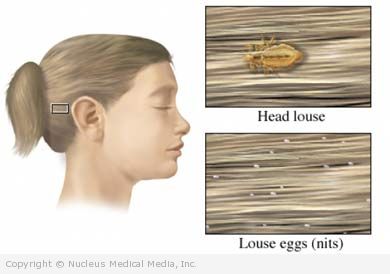Head Lice – Definition
Head lice are tiny, barely visible insect-like animals (“arthropods”) that may live on the head and cause itching. (“Lice” is plural; the singular is “louse.”) Head lice may also live in the eyebrows, eyelashes, and beard. But sometimes infestations in these areas are from a related species called pubic lice.
Head Lice – Causes
Head lice spread by personal contact and by sharing combs, brushes, hats, and other personal items.
Head Lice – Risk Factors
A risk factor is something that increases your chance of getting a disease or condition. Risk factors include:
- Age: childhood
- Sharing combs, brushes, hats, and other personal items
- Personal contact with people who may have lice
Head Lice – Symptoms
Symptoms include:
- Extreme itchiness
- Skin breaks and possible infection (caused by scratching)
- Swollen lymph nodes
- Bacterial infection (if scratching causes open areas on the scalp)
- Some persons with head lice do not have symptoms.
Head Lice – Diagnosis
The doctor will ask about your symptoms and medical history. A physical exam will be done. The doctor will examine your head and scalp for lice and lice eggs (called “nits”).
Do not self-diagnose and self-treat head lice. Some treatments can cause irritation and should only be used by people who have the infestation.
Head Lice – Treatment
Treating head lice involves removing eggs and killing lice so that they can’t continue to lay eggs. Treatment may be difficult because in some regions lice have become resistant to many of the commonly used medicines. Some experts recommend that treatment be given only when live adult lice are seen.
Methods include:
- Applying over-the-counter shampoo containing the insecticide permethrin. It is very important to use medicines as directed. Retreatment at 7-10 days is usually required to kill any lice that hatch from unremoved eggs.
- Removing lice on the eyelashes, which may be difficult. Tweezers can be used to pick them off. Vaseline may be used to coat the eyelashes and kill the lice.
- Unless instructed otherwise, remove eggs manually with specially designed combs. Eggs stick firmly to hair. Products such as “Clear,” which loosen the eggs, may assist in removal.
Over-the-Counter Medication
Most cases of head lice can be treated with over-the-counter preparations. However, there is increasing resistance to the medicines permethrin and pyrethrin in the US. There are other treatments that may be effective, like herbal remedies that contain coconut oil and anise.
Prescription Medication
Malathion is available with a doctor’s prescription. This has become a first-line treatment since malathion kills both the lice and their eggs. In certain cases, your doctor may prescribe lindane.
Lindane is neurotoxic and carries a black box warning. Follow the instructions carefully. It should only be prescribed to patients who are unable to take other medicines or who have not responded to them. According to the Food and Drug Administration’s warning, lindane can rarely cause serious side effects, including seizure and death. Those especially susceptible are infants, the elderly, children and adults weighing under 110 lbs, and individuals with other skin conditions. Lindane is toxic and should not be overused. Patients are given small amounts (1-2 oz) of the shampoo or lotion and instructed to apply a very thin layer and not to reapply.
If you or your child are diagnosed as having head lice, follow your doctor’s instructions.
Head Lice – Prevention
Lice are common, especially in children. While no records are kept for accurate counts, some estimates are that as many as 10-15 million persons annually develop head lice in the United States. To prevent outbreaks of head lice:
- Watch for signs of head lice, such as frequent head scratching.
- Don’t share combs, brushes, hats, or other personal items with people who may have lice.
- Avoid close personal contact with people who may have lice.
- If you or your children have head lice, thoroughly wash and dry combs, brushes, hats, clothing, bedding, and stuffed animals. Also, vacuum carpeting and car seats.
- If your children get head lice, notify their school, camp, daycare provider, and their friends’ parents.
- Check all family members for lice and eggs at least once a week.

